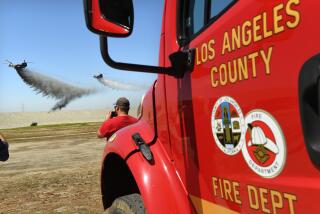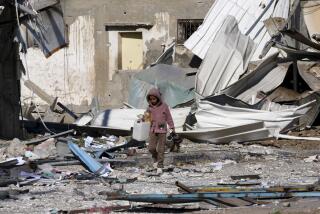Red Cross Chief Quits Amid Policy Disputes
- Share via
American Red Cross President Bernadine Healy resigned Friday, saying she had been forced out by her board over policy disputes.
Healy said the conflicts involved her plan to distribute the $500 million the agency has raised since the Sept. 11 terrorist attacks on the World Trade Center and the Pentagon and the decision to cut off dues to the International Red Cross for excluding the Israeli branch from membership.
“I had no choice,” she said at a news conference. “The board felt I was out ahead of them making policy. They didn’t have any more confidence in me.”
Healy said she will leave at year’s end.
Red Cross Chairman David McLaughlin said Friday the board did not force Healy out and will appoint an acting CEO to work with Healy until she leaves and a permanent Red Cross chief is named.
While there apparently were several issues of contention between Healy and her board, the dispute highlights questions about the agency’s plan to use a large chunk of the attack-related donations for programs that have no direct ties to the Sept. 11 events.
“One of the biggest mistakes the American Red Cross made was they didn’t move fast enough to say what they’re going to do with all the money,” said Stacy Palmer, editor of the trade publication Chronicle of Philanthropy. “They have come under enormous pressure lately to explain how they’re going to spend $500 million.
“And so far, there aren’t a lot of explanations coming that the average person who donated money is going to be happy about.”
The American Red Cross, which has 37,000 employees, supplies nearly half of the nation’s blood supplies and responds to more than 67,000 disasters a year. But industry watchers and Red Cross officials say the organization has never dealt with a disaster of such enormous scale.
The Red Cross raised about $637 million in private donations for fiscal year 2000, according to documents filed with the IRS. In the six weeks since the terrorist attacks, the group has raised at least $500 million.
Traditionally, all donations are routed to the charity’s general Disaster Relief Fund, which is used to help victims of natural disasters such as hurricanes, earthquakes and floods.
After the attacks, Healy created the Liberty Disaster Fund. It was designed to keep separate all donations received by the Red Cross since Sept. 11 for terrorism-related relief efforts, and therefore make it easier to track and target money toward victims and family members.
“I strongly oppose commingling of the moneys with any other Red Cross disaster funds,” she said, adding: “Reasonable people can differ.”
Despite the financial separation, the Red Cross only expects to distribute a portion of the fund directly to families. In an Oct. 12 statement on its Web site, the Red Cross listed seven programs to be funded by the terror-related donations. Only two--the Family Gift Program and the International Family Assistance plan--are aimed solely at survivors and family members.
The Family Gift Program set aside $100 million to be divided among the families of people who died in New York City, Pennsylvania and Arlington, Va. International Family Assistance is using $11 million to help families of foreign nationals who died. It helps pay for travel, retrieval of their loved ones’ remains and other expenses.
A third venture, dubbed Immediate Disaster Relief, earmarks $100 million to cover on-the-ground needs in the three areas. The money covers everything from “spiritual help” for survivors to the travel costs of “more than 35,000 Red Cross disaster relief workers,” according to the news release.
All told, that accounts for about 42% of the total amount that the Red Cross has raised since Sept. 11.
Of the nearly $290 million remaining, about $109 million has been set aside for plans to improve the charity’s telecommunications system, make blood supplies last longer and help staff handle terrorist attacks involving weapons of mass destruction.
The Red Cross has not said how it will spend the remaining $180 million.
Many donors and Red Cross recipients said Friday that they were willing to give the group the benefit of the doubt.
“It’s so new that I don’t think dividing the money up right away is the best way,” said Paul Neiger, a Bronx, N.Y.-based private investigator who represents two World Trade Center maintenance workers injured in the attacks. “Some time has to go by so they can finalize their list and find out who is entitled to what benefits.”
But some families who had welcomed the Red Cross’ help expressed concerns Friday about what they saw as bureaucratic waste.
The relatives of Mitchel Wallace--a 34-year-old court officer and former paramedic who was crushed as the World Trade Center collapsed as he attempted to usher victims to safety--say the Red Cross has been invaluable and has helped Wallace’s fiancee pay her rent.
Wallace’s family, who live in Brooklyn, were so impressed that they encouraged friends and relatives to donate money to the organization.
“We encouraged people to donate to them because they were so helpful,” said Arcie Wallace, Mitchel’s stepmother. “This is no good. It’s really shameful. People should be ashamed of themselves.”
The charity has run into similar controversy in the past.
In 1998, Minnesota’s attorney general criticized the agency for not spending $4 million in donations earmarked for flood victims in that state. The organization distributed the remaining funds by the end of 1999.
Afterward, the agency changed its procedures and asked local chapters to highlight the fact that donations always will help “victims of this and other disasters.”
Healy said Friday that the group always has been up front about this policy and that it is clear in the agency’s charter.
But critics are beginning to question whether the public truly understood the distinction. In towns big and small, people watched as Healy and dozens of Hollywood celebrities stood in front of cameras, pleading for the public to give blood or money.
Dozens of Red Cross television ads have run on national and local outlets since Sept. 11, according to Video Monitoring System, a New York-based firm that records and tracks TV broadcasts.
In one recent TV ad, which was paid for by the high-tech company Nortel Networks, actor Rob Lowe speaks for the Red Cross. The camera shows images of lower Manhattan, a column of smoke billowing out of where the World Trade Center once stood. When Lowe speaks, the Red Cross logo is positioned prominently to the left of the screen.
There’s no mention of how donations will be spent, but critics say that viewers inferred that their money would go to the city shown on screen: a devastated New York.
“The question is one of false advertising and whether people were led to believe something that wasn’t true,” said Palmer of the Chronicle of Philanthropy. “If you’re a careful donor, you know to read between the lines. But how much did most donors think in this case? Not a lot.”
Critics also have called the agency’s recent fund-raising overly aggressive and claimed that it hurt local efforts to collect money.
During her tenure, Healy failed to free the organization from a court-ordered consent decree with the Food and Drug Administration concerning repeated violations of rules designed to ensure the safety of donated blood. Although the consent decree was in place when Healy took over the agency, the FDA fight has escalated recently.
Healy, a 57-year-old cardiologist, took over from Elizabeth Hanford Dole in 1999. She called her support for withholding administrative dues to the International Federation of Red Cross and Red Crescent Societies a “controversial but principled stand.”
Healy’s list of accomplishments is long: a professor and researcher at Johns Hopkins, dean of the Ohio State University medical school, former head of the American Heart Assn. and former director of the National Institutes of Health.
*
Times staff writer Peter Y. Hong and Associated Press contributed to this report.
More to Read
Sign up for Essential California
The most important California stories and recommendations in your inbox every morning.
You may occasionally receive promotional content from the Los Angeles Times.














